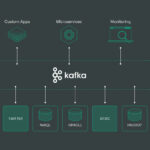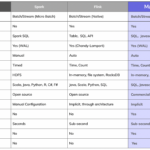In the realm of Big Data, the abundance of information from diverse sources poses a significant challenge in extracting valuable insights efficiently. Artificial Intelligence (AI) has emerged as a crucial tool for summarizing large-scale heterogeneous data sources, offering the potential to accelerate data analysis and decision-making processes. By leveraging AI algorithms, businesses can sift through vast amounts of data, identify patterns, and extract key information to drive informed strategies. This article delves into the role of AI in handling the complexities of diverse data sources within the context of Big Data, highlighting its impact on enhancing data interpretation and facilitating data-driven decisions.
The emergence of Big Data has revolutionized the way organizations collect, process, and analyze information. However, the vast amounts of data generated from heterogeneous sources often pose a challenge for effective analysis. Here, Artificial Intelligence (AI) plays a crucial role in summarizing and extracting meaningful insights from these large-scale datasets.
Understanding Big Data
Big Data refers to datasets that are too large or complex for traditional data-processing software to manage. These datasets can come from various sources, including:
- Social media interactions
- IoT sensor data
- Enterprise databases
- Multimedia files
- Web logs
This variety not only includes structured data like spreadsheets but also unstructured data such as text, images, and videos, leading to challenges in analysis and interpretation.
The Challenge of Heterogeneous Data Sources
Data from heterogeneous sources can vary significantly in terms of format, structure, and semantics. This diversity makes it difficult to perform effective data integration and analysis. Traditional methods often fall short, leading to inefficiencies and missed opportunities for insights.
Challenges include:
- Data Volume: The sheer amount of data can overwhelm conventional processing techniques.
- Data Variety: Different formats require different approaches for handling and analysis.
- Data Veracity: Ensuring the accuracy and trustworthiness of data is vital.
- Data Velocity: The speed at which data is generated requires real-time processing capabilities.
How AI Facilitates Data Summarization
AI technologies offer innovative solutions to overcome these challenges by providing advanced methods for summarizing and analyzing heterogeneous data. Here are several ways AI contributes:
1. Natural Language Processing (NLP)
NLP techniques allow AI systems to process and understand human language. By applying NLP, organizations can:
- Extract meaningful keywords and phrases from unstructured text.
- Summarize articles, documents, and customer reviews quickly and effectively.
- Identify sentiment and opinions in social media posts for better market analysis.
2. Machine Learning Algorithms
Machine Learning (ML) algorithms enable AI to learn from previous data inputs, improving their performance over time. ML can be utilized to:
- Identify patterns and trends within large datasets.
- Group similar data points through clustering techniques.
- Predict future outcomes based on historical data.
3. Automated Data Integration
AI can automate the integration of data from multiple sources, standardizing formats and ensuring consistency. This capability facilitates:
- Data cleaning by identifying duplicates and inconsistencies.
- Data fusion, which combines data from different sources to create a comprehensive view.
- Seamless data blending, enabling user-friendly access to multidimensional data.
4. Visualization Techniques
AI-driven visualization tools convert complex data into easily interpretable visuals. These tools can:
- Highlight key insights through graphical representations like dashboards, graphs, and heatmaps.
- Facilitate stakeholder understanding of data trends without requiring technical expertise.
- Provide interactive options for users to explore data from multiple angles.
Case Studies of AI in Data Summarization
Real-world applications of AI in summarizing heterogeneous data showcase its effectiveness:
1. Healthcare Analytics
Healthcare organizations use AI to summarize patient data from various sources, including electronic health records (EHR), imaging data, and wearable devices. By integrating these datasets, AI can:
- Provide health predictions based on individual metrics.
- Identify at-risk populations for proactive care and interventions.
- Summarize treatment efficacies based on similar case histories.
2. Financial Services
In finance, institutions employ AI to analyze market trends by summarizing data from global news, trading logs, and financial statements. This analysis aids in:
- Detecting fraudulent activities through pattern recognition.
- Generating investment insights for portfolio management.
- Automating compliance monitoring by summarizing relevant regulatory changes.
3. Retail and E-commerce
Retailers are utilizing AI to summarize customer behavior data from sales transactions, online reviews, and social media interactions. This information allows businesses to:
- Personalize marketing strategies based on customer preferences.
- Optimize inventory management by predicting demand patterns.
- Enhance customer experience by understanding feedback and complaints.
Future Trends in AI and Big Data Summarization
As AI technology continues to evolve, the future holds significant prospects for enhancing data summarization in Big Data:
1. Advanced AI Algorithms
We can expect developments in advanced AI algorithms capable of performing even more sophisticated analyses of heterogeneous data. These algorithms will likely include:
- Deep learning models able to process complex non-linear relationships.
- Reinforcement learning techniques that adapt based on outcomes in real-time.
2. Enhanced Real-time Processing
The integration of edge computing with AI will facilitate enhanced real-time data processing, allowing organizations to summarize and act on data immediately as it flows in.
3. Improved Data Governance
With increased focus on data privacy and regulation, AI will play a key role in ensuring compliance through automated summarization and reporting mechanisms.
4. Democratization of AI
As AI tools become more accessible, businesses of all sizes will leverage AI for summarizing heterogeneous data, driving innovation in diverse sectors.
Conclusion
AI is transforming the landscape of Big Data by empowering organizations to summarize vast and diverse datasets effectively. Through techniques such as NLP, ML, automated data integration, and visualization, AI enhances the ability to derive insights from large-scale heterogeneous data sources. As technology advances, we can anticipate even greater capabilities for summarization and analysis, further solidifying AI’s role in the Big Data ecosystem.
The integration of AI technologies in summarizing large-scale heterogeneous data sources within the realm of Big Data has proven to be invaluable. By leveraging machine learning algorithms and natural language processing capabilities, AI enables organizations to efficiently extract meaningful insights and trends from diverse datasets, ultimately enhancing data-driven decision-making processes and driving innovation across various industries. The continuous advancements in AI will play a critical role in addressing the challenges associated with analyzing complex and ever-expanding data sources, making it an indispensable tool in the era of Big Data analytics.














